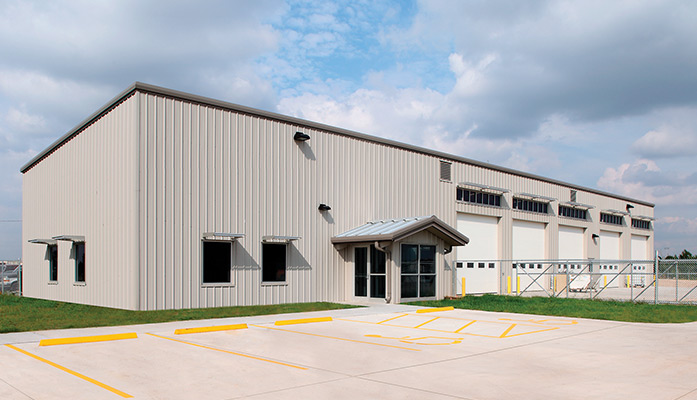As we remember the anniversary of the devastating F5 tornado that threatened to make the entire town of Greensburg, Kansas a memory, you’d be hard-pressed to find anyone who hasn’t heard of the resiliency of its citizens, and the monumental effort to rebuild the rural city—but most people haven’t given much thought to the maintenance and waste management needs of the area.
The original Kiowa County Maintenance Facility was completely destroyed by the tornado, along with several other buildings a county needs to adequately maintain its roads and streets. The facility provided key services to Kiowa County, as it not only provided storage and maintenance for equipment, but also served as a recycle center and a hazardous waste disposal center for the community. Being so important to the revitalization of the county, the Kiowa County Maintenance Facility was one of the fir
st buildings TESSERE was commissioned to design for the rebuilding of county facilities.
Using the integrated design approach that involves all participants—owner, architect, engineers, contractor, users, and the U.S. Department of Agriculture—a “green” maintenance facility was created that includes many energy-efficient and energy-saving elements. These design features not only counted toward the Leadership in Environmental and Energy Design (LEED) certification the county was seeking but also provided the necessary tools for significant energy cost savings for the building.
The new complex includes three pre-engineered metal structures: a transportation building, a recycling center and a storage building. The transportation building includes vehicle maintenance shops and equipment storage and also houses administrative offices. The recycling center includes space for basic recycling services as well as a household hazardous waste and e-waste depository, while the storage building includes space for both chemical and equipment storage.
A creative method of achieving energy-efficiency in the building was the utilization of a geothermal system for heating and cooling. Just a few feet below the surface, the earth stays a constant 50 to 55 degrees Fahrenheit year-round. Geothermal heat pumps (also referred to as earth-coupled, ground-source or water-source heat pumps) use the earth’s constant temperature for heating and cooling rather than the outside air temperature. Geothermal wells are drilled between 250 and 300 feet below the earth’s surface and work in conjunction with geothermal heat pumps to heat and cool. A total of 18 geothermal wells were drilled at the Kiowa County Maintenance Center as part of their ground-coupled heat pump system, which provides climate control for the facility. The technology, which has become more popular as energy costs continue to soar, uses up to 50 percent less electricity than conventional systems, and can reduce energy consumption by up to 72 percent.1 And unlike any other HVAC system on the market, a geothermal heat pump system can provide free hot water by transferring excess heat from the pump’s compressor to the hot water tank. This can translate into BIG savings on monthly utility bills!
Another area in which significant energy cost savings can be realized is in lighting. In fact, unoccupied lit rooms account for nearly $1.7 billion in wasted energy costs annually2. To help Kiowa County break away from this statistic, a sophisticated daylighting system was incorporated into the complex, which reduced the need for electric lighting. Clerestory windows were designed above the overhead doors to provide significant natural light in the maintenance bays, and specially designed sun shades and fins were fitted over energy-efficient windows to redirect natural lighting to maximize its effect. Daylighting controls and photocells (electrical devices that convert the energy of light into electricity) automatically adjust the intensity of the artificial light if enough natural light is present. These energy-saving features are key as reduction of energy costs becomes more and more important.
Conserving water is another important issue. Low-flow, high-efficiency water fixtures can be found in each building of the maintenance complex. A total of 260 water-conserving showerheads and 400 dual-flush toilets were donated to Greensburg after the tornado, several of which were used at the Kiowa County Maintenance Facility. Another water-conserving feature of the complex is the natural landscaping, which utilizes aesthetically pleasing layouts and native plants suitable to the local conditions, while eschewing the extensive watering and fertilization other approaches require. In addition to lowering the water consumption of the facility, the natural landscaping approach results in decreased energy usage, reduced stormwater runoff, reduced labor and maintenance costs, and extended life for water resources infrastructure resulting in reduced taxpayer costs.3
The Kiowa County Maintenance Facility achieved LEED Silver certification in 2009. TESSERE Architecture provided site planning, architecture, interior design and landscape architectural services.
1 Benefits of Geothermal Heat Pump Systemshttp://www.energysavers.gov/your_home/space_heating_cooling/index.cfm/mytopic=12660
2 Building Commissioning: A Golden Opportunity for Reducing Energy Costs and Greenhouse Gas Emissions in the United States http://evanmills.lbl.gov/pubs/pdf/cx-enef-mills.pdf
3 Water Efficient Landscaping: Preventing Pollution & Using Resources Wisely http://www.epa.gov/npdes/pubs/waterefficiency.pdf




